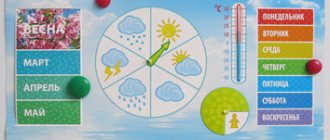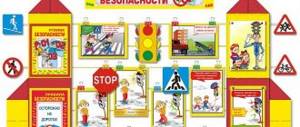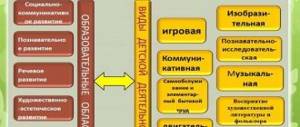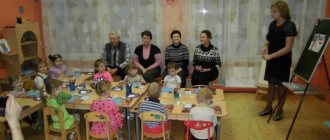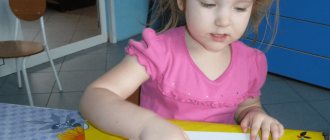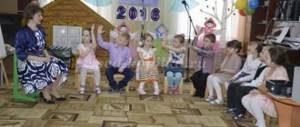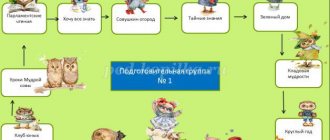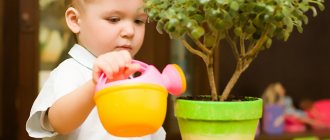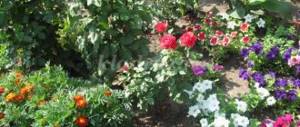MAGAZINE Preschooler.RF
Master class on working with the nature calendar (Work experience) own developmentIf we love our children, we must tenderly
and carefully love the Earth and pass it on to future generations in all its diversity and beauty, so that on a warm spring day ten thousand years later they could appreciate the peace in the sea of grass, admire the bee circling around the flower, listen to the lark singing in the sky and feel the joy of life as such.
Hugh. H. Iltis
MASTER CLASS ON WORKING WITH NATURE'S CALENDAR (Author's development)
According to the Federal State Educational Standard, in each kindergarten group it is necessary to create nature and weather corners to familiarize children with nature and natural phenomena.
Each teacher approaches the design of a corner of nature in his own way.
Carrying out such work, the teacher faces a number of tasks:
- children's horizons and ideas expand
- ideas about objects and phenomena of reality develop and become more precise
- certain logical connections and dependencies between them are established
- vocabulary is enriched
- observation and sustainable cognitive interest develop.
And colorful design, under the guidance of a teacher, becomes a means of aesthetic and moral education. Children develop an artistic perception of reality. But we cannot always choose a calendar that would satisfy us in terms of content, and yet different regions of our huge country have different climatic conditions. When gardens are already blooming in the south, it’s snowing in the Middle Volga, etc. Therefore, I preferred to make a nature calendar myself to solve the tasks.
The first task that confronted me was how best to consolidate children’s knowledge about the seasons and months. This problem is solved by the "Magic Steam Locomotive" , which carries multi-colored carriages: white - winter (3 pcs.), green - spring (3 pcs.), red - summer (3 pcs.), yellow - autumn (3 pcs.), which are transported month. All carriages are removable, with Velcro. For example: my children and I fix the season - winter. Children attach 3 white carriages to the main locomotive, which carry a picture of each month. This way, children understand that if the carriages are white, then in the time of year Winter there are mainly white colors (snow, ice, etc.), comparisons are made, they remember the sequence of months, and that each month is diverse in its weather phenomena. And so on for all seasons. And so that children can navigate them, and not just memorize them automatically, I conduct various confusion games for attention. For example, I either put cars from one season in different sequences, or I take cars from another season. Children try to do all the work themselves.
Another problem I solve is fixing the days of the week. They are made in the form of smoke rings that come out of the chimney of a steam locomotive. The smoke has the colors of the rainbow, and is displayed in a given sequence. For example, if today is Monday, then the children attach a red smoke ring over the chimney of the locomotive, while pronouncing the name of the day of the week and what day it is. When Tuesday comes, children move the red smoke ring to the right, and place an orange smoke ring above the pipe, etc. until the end of the week. This is how children remember that the days of the week have their own sequence and consolidate knowledge and concepts - yesterday, today, tomorrow, the day after tomorrow, etc. The same game is played with days and weeks as with carriages, and the game “Which day is missing” , when children must determine which day is missing and pronounce it.
Also, with the help of an observation calendar, I solve the problem of teaching people to notice changes in nature: it’s getting colder, it’s raining, birds are flying to warmer climes. For this purpose, removable weather phenomena have been made (sun, clouds, clouds with raindrops, snowflakes, lightning, wind, etc.).
The main task of the nature calendar is to attract children’s attention to nature, expand and clarify ideas about nature, teach observation, and develop curiosity.
| Next > |
Working with the nature calendar
In the middle group, it should be simple in terms of the material presented, and bright. With the help of a calendar, you can preserve in children’s memory for a long time interesting impressions from observations on the site, walks, excursions. The children's drawings reflecting what they saw are placed by the teacher on the calendar. In this case, you should select those that most accurately or figuratively represent what you saw.
The changing weather of the season also needs to be recorded. This can be done using the teaching toy “What is the weather today?”
On a thick piece of cardboard with a movable arrow fixed in the center, images of different weather conditions, but typical for a particular season, are placed or placed in transparent pockets for children's drawings. If you make the pictures interchangeable, you can use the calendar throughout the year. By combining a teaching toy with a tablet for children's drawings, already in the middle group you can create a corner for observing nature and the weather of the season. Keeping such calendars accustoms children to attention, develops the ability to observe, notice interesting and typical natural phenomena in spring, autumn, winter and summer.
In the older group of kindergarten, the nature calendar can be somewhat complicated, since children of the sixth year of life have increased the ability to perceive and comprehend natural phenomena, reflect what they see in drawings, as well as simple schematic images. Seasonal natural phenomena and weather conditions can be presented in the calendar in more detail using symbols . At the same time, the teacher should use the calendar not only as a means of recording children’s observations, but also to develop their ability to “read” the calendar.
Observation, which has increased by older preschool age, as well as the knowledge accumulated by children about weather variability, makes it possible to use a significant number (6-7) of conventional images of weather phenomena . For example, autumn weather phenomena can be represented by conventional images.
By the second half of the year, children in the older group have some basic knowledge about time (day, week). Therefore, the teacher can add a conventional image of the week (a strip with cells according to the number of days of the week) and teach children to independently note the weather conditions . Such fixed observations make it possible to show children the variability of weather, the dynamism of natural phenomena in a relatively short period of time, and also to consolidate ideas about the days of the week.
The nature calendar in the older group, as well as in the middle group, should include the most interesting drawings of children , reflecting their observations of the weather, the life of plants and animals, and people. The teacher should encourage children to make independent observations , express interest in this activity, evaluate it positively, create the need to sketch what they saw, talk about it using their drawing. Near the nature calendar it is good to have everything you need for drawing - paper, pencils or paints.
Nature calendars are designed differently in the older group. For example, at the beginning of the year, a calendar with a slight complication compared to the average group may be used. In it, plot pictures depicting various seasonal phenomena are replaced by conventional images. Images of new weather conditions are added.
In the second half of the year, children independently depict observed weather phenomena with conventional symbols and place them in the cell corresponding to the days of the week
Just like in previous groups, in the preparatory group a nature calendar is kept. It is placed in a corner of nature.
An important part of the calendar in the pre-school group is a sheet reflecting weather conditions during the month. In the cells corresponding to the days and weeks of the month, children record the weather conditions every day, using symbols for this. At the end of the month, with the help of the teacher, the number of sunny, cloudy, windy, rainy and other days is calculated and a conclusion is drawn about the prevailing weather conditions during the month.
In the second half of the year, it is recommended to note the weather conditions twice a day. To do this, each cell of the calendar is divided diagonally into two parts: morning and evening, and the weather is noted after a morning walk and before going out for an evening walk.
Forms of maintaining a calendar in a preparatory school group can be different. You can use a wall calendar .
The formation of ideas about the time of year can be carried out using a screen calendar, which has three columns: “Week”, “Weather”, “Wildlife”. The first column includes four vertical stripes indicating the days and weeks of the month. In order for children to better navigate the days of the week and learn their order, you can introduce colored images (for example, Monday - purple, Tuesday - blue, Wednesday - blue, Thursday - green, Friday - yellow, Saturday - orange and Sunday - red) .
In the second column (“Weather”), for one week (any week), the weather condition is noted daily using symbols that children can understand. Together with the children, the teacher can choose such icons and agree on what they mean. The third column contains children's drawings reflecting the state of plants, animals seen (birds, insects, animals) at a specific place in the kindergarten or in the immediate natural environment. This allows children to observe how the same place changes during a certain time of the year - spring, summer, autumn, winter - and draw a conclusion about the gradualness of the changes occurring, the increase or decrease in the effect of certain factors of inanimate nature that determine changes in living nature in season.
2. Environmental education in younger groups at different times of the year in classes and in everyday life, recording impressions.
Didactic manual “Nature Calendar”
Participant of the exhibition-competition:
Ryzhkova Larisa Viktorovna,
teacher,
highest qualification category.
MADOU d/s No. 132 of the city of Tyumen
Annotation:
While working in kindergarten, I noticed that children have difficulty determining the seasons by their characteristic features, they confuse the names of the months and their sequence in the calendar year. To help children learn this material, I made my own nature calendar.
This calendar is a large circle with a rotating arrow, divided into four sectors. Each sector has its own color, which corresponds to a specific season of the calendar year: blue (cyan) - winter, green - spring, red - summer, yellow - autumn. For each season there are cards - illustrations and colored clothespins - symbols of the months of the year.
Working with this calendar, children successfully learn the features of natural objects, connections and relationships. Children really enjoy manipulating the colored clothespins and developing fine motor skills.
Keeping such a calendar develops in children attention, the ability to observe, notice interesting and typical natural phenomena in spring, autumn, winter and summer.
Examples of games:
“When does this happen?”
Goal: to consolidate children’s knowledge about the characteristic features of the seasons of the year, the ability to establish cause and effect relationships. After the arrow stops, children select cards that reflect the characteristics of the season.
"Pick up cards"
Goal: to generalize and systematize children’s ideas about seasonal phenomena in inanimate nature, their impact on the animal world and the plant world.
Game task: select cards - models that reflect the characteristic features of seasonal phenomena in the world of living and inanimate nature.
“Who will we meet?”
Goal: to consolidate children’s knowledge about the lifestyle of wild animals at different times of the year.
Game task: rotate the arrow, after the arrow stops arbitrarily, select pictures depicting those animals that can be found at one time or another of the year.
"Confusion"
Goal: to develop children's attention, visual - imaginative thinking, speech - proof, and the ability to notice inconsistencies. The teacher incorrectly places clothespins (or cards depicting signs of the seasons), the children find the mistakes and explain them.
"Seasons"
Goal: to consolidate knowledge of the signs of different seasons, to cultivate cognitive interest.
Game task: distribute clothespins into sectors and name the signs of each season of the year.
The calendar is very mobile: you can use it as a guide in different educational activities, in didactic games, and in individual work.
This calendar model has no age restrictions. By complicating and modifying the main content of the calendar, it can be used in all age groups.
Dear competitors and guests! From May 15 from 12-00 to May 19 until 20-00 2020 Online voting for the “People's Choice Award” took place on the portal. (4 winners were determined, 1 from each nomination) VOTING RESULTS >>>
1,2,3 PLACE in the exhibition-competition is determined by the jury. (12 contestants)
16 winners will be solemnly awarded on June 23 in the Great Meeting Hall of the Tyumen Regional Duma.
Laureates of I, II and III degrees are awarded diplomas, valuable gifts and letters of gratitude from the Deputy Chairman of the Tyumen Regional Duma. Each participant receives a certificate confirming participation in the regional event.
Invite your friends and acquaintances to support the competition participants! You can put a call to vote for your kindergarten in your news feed, create a support group.
Leave meaningful comments; their number will not be counted.
Share
